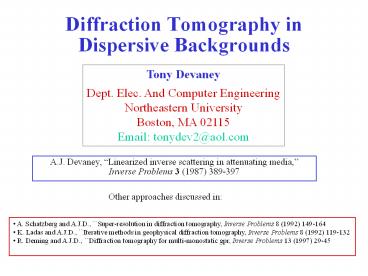Diffraction Tomography in Dispersive Backgrounds
1 / 15
Title:
Diffraction Tomography in Dispersive Backgrounds
Description:
Diffraction Tomography in Dispersive Backgrounds Tony Devaney Dept. Elec. And Computer Engineering Northeastern University Boston, MA 02115 Email: tonydev2_at_aol.com –
Number of Views:88
Avg rating:3.0/5.0
Title: Diffraction Tomography in Dispersive Backgrounds
1
Diffraction Tomography in Dispersive Backgrounds
Tony Devaney Dept. Elec. And Computer
Engineering Northeastern University Boston, MA
02115 Email tonydev2_at_aol.com
A.J. Devaney, Linearized inverse scattering in
attenuating media, Inverse Problems 3 (1987)
389-397
Other approaches discussed in
- A. Schatzberg and A.J.D., Super-resolution in
diffraction tomography, Inverse Problems 8 (1992)
149-164 - K. Ladas and A.J.D., Iterative methods in
geophysical diffraction tomography, Inverse
Problems 8 (1992) 119-132 - R. Deming and A.J.D., Diffraction tomography
for multi-monostatic gpr, Inverse Problems 13
(1997) 29-45
2
Experimental Configuration
n(?)
O(r,?)
s0
s
Generalized Projection-Slice Theorem
E. Wolf, Principles and development of
diffraction tomography, Trends in Optics, Anna
Consortini, ed. Academic Press, San Diego, 1996
83-110
3
Born Inverse Scattering
kreal valued
Ewald Spheres
k
2k
Ewald Sphere
Limiting Ewald Sphere
4
Born Inversion for Fixed Frequency
Problem How to generate inversion from Fourier
data on spherical surfaces
Inversion Algorithms Fourier interpolation
(classical X-ray crystallography) Filtered
backpropagation (diffraction tomography)
A.J.D. Opts Letts, 7, p.111 (1982)
Filtering of data followed by backpropagation
Filtered Backpropagation Algorithm
Fourier based methods fail if k is complex Need
new theory
5
Pulse Propagation in a Dispersive Background
n(?)
O(r,?)
s0
s
6
Fourier Transformed Scattered Field
Close in u.h.p.
Choose a complex frequency ?0 such that k (?0 )
is real valued
There is no reason a priori to dismiss this
possibility, but will it work?
Roots of dispersion relationship with real k are
in l.h.p.
7
Simple Conducting Medium
Complex in l.h.p.
Real valued
Im ?
Complex ? plane
Branch point
X
?lt0
X
Desired frequency ?0
Re ?
Will not be able to close in u.h.p. can only
drop contour to branch points
8
Lorentz Model
b220x1032 ?016x1016 ? .28x1016
Real n
Imag n
K.E. Oughstun and G.C. Sherman, Electromagnetic
Pulse Propagation in Causal Dielectrics
Springer-Verlag, 1994, New York
9
Lorentz Medium
Im ?
Complex ? plane
Re ?
?lt0
-?
Desired frequency ?0
X
?-
?
x
x
Poles of n(?)
Branch Cuts
Roots of dispersion relationship must lie above
branch points
Im ?0gt-?
10
Contour Plot of Re ik(?)
Im ?
Re ?
Real k
Branch point
11
Mesh Plot of Re ik(?)
12
Exciting the Plane Wave
n(?)
s0
O(r,?)
Close in l.h.p.
Non-attenuating mode of medium
13
The Complete Pulse
Im ?
Complex ? plane
Re ?
?0
-?0
X
X
Branch Cuts
Precursors
Can the non-attenuating plane wave be excited
i.e., is it dominated by the precursors?
14
Asymptotic Analysis
K.E. Oughstun and G.C. Sherman, Electromagnetic
Pulse Propagation in Causal Dielectrics
Springer-Verlag, 1994, New York
Im ?
Steepest Descent Contour
Complex ? plane
Saddle point
X
Re ?
?0
-?0
X
X
X
X
X
Saddle point
X
Saddle point
Plane wave excited
Plane wave not excited
15
Summary and Questions
- Have reviewed one possible approach to inversion
in dispersive backgrounds - Method is based on computing the temporal
Fourier transform of pulsed data - at complex frequencies for which the wavenumber
of the background is real - Method will not work for simple conducting media
but appears feasible for - Lorentz media
- The idea behind the approach suggests that it
may be possible to excite - non-decaying, plane wave pulses using complex
frequencies - Asymptotic analysis is required to determine the
feasibility of the theory































